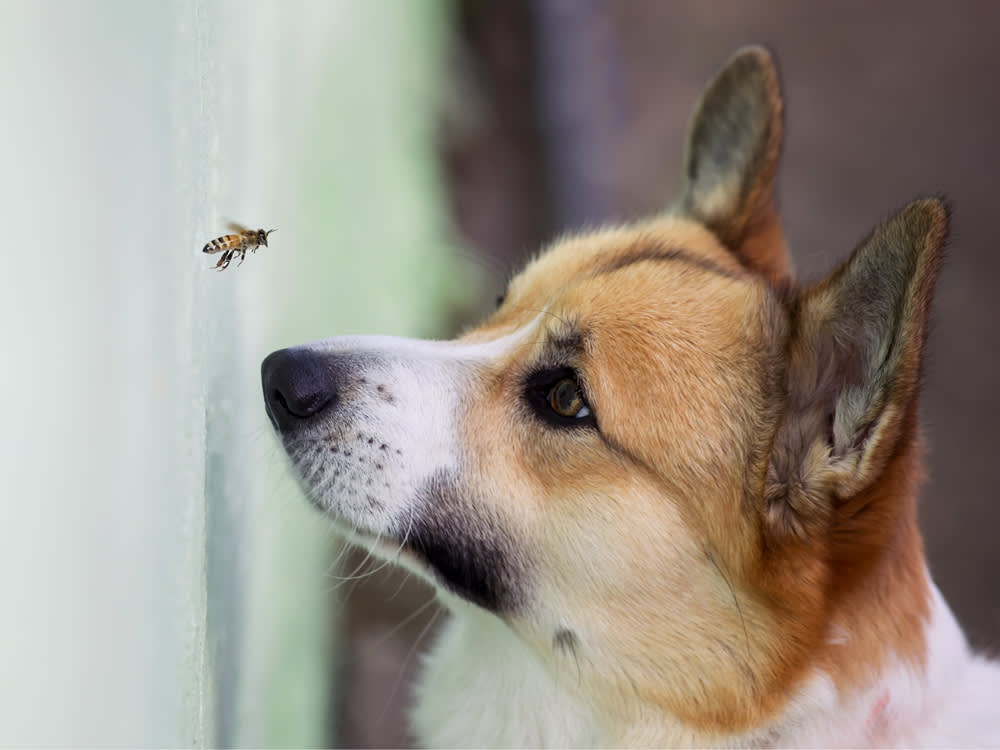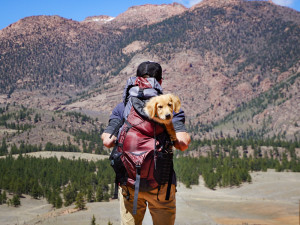What to Do If Your Dog Gets Stung By a Bee
From how to get the stinger out at home to when it’s time to go to the ER.

Share Article
The flowers are in full bloom this summer, but stopping to smell the roses increases your dog’s chances of getting stung by a bee. I kicked off my Saturday morning shift at the vet hospital by treating the cutest puffy-faced dog who experienced his first acute allergic reaction.
In my experience, most pet parents won’t even notice that their pup has suffered a bee string, which is why there’s so much bewilderment and concern when their dog’s mouth blows up like a balloon. Below, find a guide for what to do if your dog accidentally bites a bee, how to remove a stinger, and when to see a vet.
How to know when your dog is stung by a bee
When a bee stings a dog, it usually results in an acute allergic reaction, a common veterinary emergency. The typical culprits that bite and sting dogs are bees, wasps, and spiders. Pet parents may not always know when their animal has been stung since bees are the only insects that actually leave stingers behind. Because they are curious sniffers and use their mouths to explore their environment, dogs are usually stung on their mouths, faces, and paws, but stings can occur anywhere on their bodies.
Your dog might be sniffing a pee spot among some flowers, or maybe they just see a bug and try to catch it — or even eat it — getting a nasty sting in the process. If your dog swallows a bee or gets stung inside the mouth, it can be difficult to detect the stinger, so it’s crucial to watch for symptoms such as difficulty breathing, vomiting, weakness, pale gums, or collapse and take your dog to a vet immediately.
Symptoms of a dog bee sting or insect bite
Dogs who are stung or bitten can experience everything from mild to life-threatening reactions depending on if they have a severe allergic reaction to the toxin. If there are any signs of facial swelling, vomiting, breathing difficulty, or collapse, have your dog examined by a veterinarian immediately. Mild clinical signs can quickly become severe, and early treatment will generally prevent continued progression of the reaction.
Mild reaction symptoms of a dog bee sting or insect bite
Swollen or puffy face
Swelling around the eyes
Redness around the eyes
Lumps and bumps over the skin
Redness of the skin
Head shaking
Itchiness
Anaphylactic reaction symptoms of a dog bee sting or insect bite
Just like humans, dogs can be allergic to bee stings. Research shows that approximately one to five percent of people have a severe allergy to bees, but there isn’t any data on the prevalence in dogs.
If a dog is allergic to bees, they can experience more severe symptoms — called an anaphylactic reaction — after a bee sting. Anaphylactic symptoms develop within minutes after a sting and can be life-threatening. Symptoms of an anaphylactic reaction to bee stings include:
Facial swelling
Severe itching
Hives
Vomiting
Collapse
Staggering
Pale gums
Swelling of the larynx
Difficulty breathing
Difficulty swallowing
Most dogs who I see for anaphylaxis are reported to have vomited once followed by collapsing, and when I perform a physical exam, I generally see pale gums and a poor pulse, indicating a state of shock.
What to do if your dog is stung by a bee or insect
You need to take your dog to the vet if they have been stung by a bee and show any signs of an allergic reaction. While seeking medical care, you can also remember the A-Bee-Cs of bites and stings:
“A” is for assist
When a honeybee stings a dog, its stinger becomes detached from its body and the bee dies. What’s left in the dog is the stinger and a tiny piece of fleshy-looking tissue, the venom sac. Wasps or bumblebees, on the other hand, can sting repeatedly because their stingers do not detach.
If your pet was stung, try to locate a stinger. If there is one, try to remove it by scraping it out with a credit card or plucking it out with tweezers. Be careful not to put pressure on the venom sac during its removal, because this will inject more venom into your dog. If you don’t feel confident in removing the stinger, wait until your veterinarian can do it.
If your dog has been stung by a bee and you can’t find the stinger, the stinger may have already fallen out or be located in an area that is difficult to see. Once you get to the vet, inform them of the possible stinger location so they can do a closer inspection.
“B” is for baking soda
To help neutralize some of the acidic venom, apply a paste of baking soda mixed with water to the sting area.
“C” is for cool compress
Apply a cool compress to the area to help reduce swelling and pain. This will also help constrict the blood vessels, thereby “slowing” the spread of venom.
Can I give my dog Benadryl for a bee sting?
Benadryl (diphenhydramine) is considered generally safe for dogs. But if your dog is stung by an insect, do not give your dog any medications before contacting your vet. If your dog has any symptoms of a bee sting, such as a swollen face, that’s a sign that your dog requires immediate veterinary attention; contact your vet before giving your dog Benadryl for a swollen face.
One exception: Pet parents who go on remote hikes without access to professional care often raise concerns about needing more immediate emergency treatment. In these cases, you can carry with you, and give if needed, one milligram of Benadryl (which is typically administered by injection) orally for every one pound of body weight. (For example, a 50-pound dog can get 50 milligrams of Benadryl.) Giving your dog Benadryl is not a substitute for veterinary care, but can be helpful at “buying time” as you make your way to the closest vet office.
Can anaphylaxis be prevented?
The primary way to prevent anaphylaxis is to avoid stings. In general, there is no way to predict if a dog will have an allergic reaction to a bee sting or whether it will be mild or severe. Some dogs have no reaction to an initial sting, and a severe reaction to the next.
Avoid areas with bees
When outside with your dog, keep an eye out for foraging bees on flowers, swarms of bees, and beehives — especially if Africanized bees, a more aggressive version of the European honeybee, live in the area. Keep pets from investigating under porches, houses, shrubbery, or known locations of nests/hives.
Watch for other insects
Dogs should also be wary of wasp nests and yellow jacket burrows, which can be a source of multiple stings if a dog gets too close. A single sting may not seem like a big deal, but multiple stings or a single sting for an allergic dog can be life-threatening and potentially have long-term complications.
Use an epi-pen for dogs
If your dog has more than one severe reaction to an insect sting, address the issue with your vet. You can ask them about getting a prescription for an “epi-pen” if your dog has experienced an anaphylactic reaction in the past. This is a special syringe filled with a single dose of epinephrine and is similar to the type used for people who are highly allergic. You can carry this with you on trips or hikes and use it if your dog experiences another severe reaction.
Though insect stings are never pleasant — for dogs or humans — prompt veterinary care can minimize the effects and ensure your dog has a safe, pleasant experience with the great outdoors.
FAQs (People Also Ask)
What do I do if my dog gets stung by a bee?
Try to locate and remove the stinger (be careful of the venom sac), neutralize the venom with a baking soda mix, apply a cool compress, and contact your veterinarian immediately.
Do I need to take my dog to the vet if they are stung by a bee?
Yes, if your dog gets stung by a bee, you should take your dog to the veterinarian. Bee stings in dogs can result in mild to life-threatening symptoms, and there’s no way to predict your dog’s reaction.
Can I give my dog Benadryl for a bee sting?
Yes, Benadryl (diphenhydramine) is often given to dogs to help alleviate symptoms of mild to moderate allergic reactions. Consult your veterinarian before giving your dog any medication.
Is a bee sting on a dog an emergency?
Bee stings in dogs are a common veterinary emergency because they usually result in an acute allergic reaction requiring veterinary attention.
How do I know if my dog got stung by something?
If you’re unsure if your dog was stung by a bee, look for symptoms such as swelling (especially around the face, throat, or paws), hives, difficulty breathing, vomiting, diarrhea, or collapsing, and seek immediate veterinary care.
How do you know if your dog was stung in the mouth?
If your dog is stung inside their mouth or swallowed a bee, they may experience symptoms such as swelling, coughing, drooling, rapid breathing, vomiting, and diarrhea — seek immediate veterinary care.
References:

Dr. Shea Cox, DVM, CVPP, CHPV
Dr. Shea Cox is the founder of BluePearl Pet Hospice and is a global leader in animal hospice and palliative care. With a focus on technology, innovation and education, her efforts are changing the end-of-life landscape in veterinary medicine.
Related articles
![Man backpacking with his Golden Retriever puppy in a state park]()
51 Dog-Friendly US Spots to Visit With Your Pup This Summer
Where to go and what to do—from Alabama to Wyoming.
![Cute weimaraner dog lying on lawn and scratching its back]()
Best Allergy Medicines That You Can Give to Your Dog
Here’s what works (and what doesn’t).
![A black and a white chihuahua both playing in the grass]()
How to Protect Your Dog from Hawks and Other Birds of Prey
Hawk attacks on dogs are more common than you might think — here's how to keep your pup safe.
![Dog on leash running in a field without foxtails]()
Why Foxtails Are So Dangerous for Your Dog
Late spring is prime time for these blades of grass that pose a serious risk to your pup.
![Woman holding a beagle in warm dappled summer light]()
You’ve Got a Summer-Lovin’ Pup. Here’s How to Keep Them Safe
Some like it hot (but not most dogs). Here are the season’s health hazards, from fleas to foxtails.
![Owner and their dog outside in the summer.]()
It’s Hot Out There—Here’s How to Protect Your Pup’s Paws
Those perfect little toe beans need all the help they can get.











